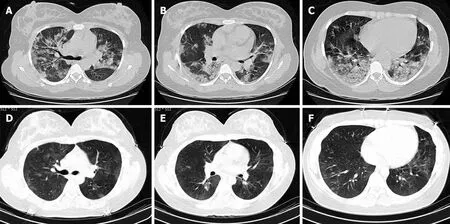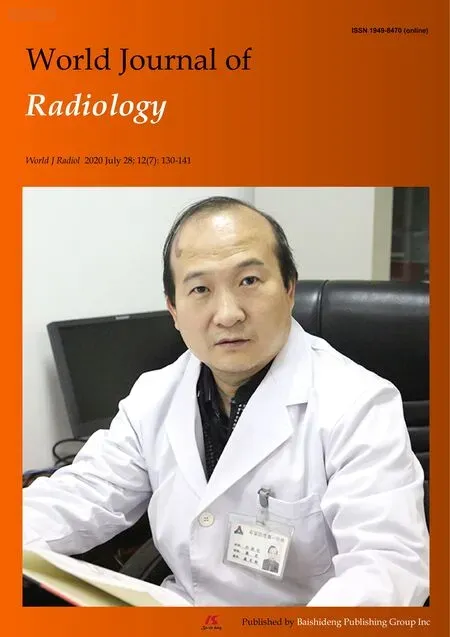Convalescent plasma therapy in a pregnant COVID-19 patient with a dramatic clinical and imaging response: A case report
Ramezan Jafari, Nematollah Jonaidi-Jafari, Fatemeh Dehghanpoor, Amin Saburi
Abstract
Key words: Case report; Convalescent plasma therapy; Pregnancy; COVID-19; Favipiravir; Radiologic findings
INTRODUCTION
Coronavirus disease 2019 (COVID-19) caused by a novel Coronavirus was first identified in Wuhan (China) in December 2019. The spread of COVID-19 was so rapid that within a few months it became a pandemic. The most common presentations of COVID-19 are cough, fever, dyspnea, and malaise, but some patients present severe manifestations such as respiratory failure, acute respiratory distress syndrome, septic shock, multi-organ failure, and disseminated intravascular coagulation (DIC). Comorbidities such as diabetes, hypertension, chronic cardiovascular diseases, pulmonary disease, and malignancies exacerbate the disease, particularly in older patients and pregnant women, especially in the third trimester. Pregnant women are a sensitive group, therefore are susceptible to severe manifestations and complications of COVID-19. Thus, to avoid probable complications these patients should be treated appropriately and immediately.
CASE PRESENTATION
Chief complaints
A 26-year-old woman with a twin pregnancy at 36 wk and one day gestation (gravida 1, 0 abortions) was referred to our emergency unit.
History of present illness
The patient presented with malaise, fever, and a non-productive cough for 6 d prior to admission.
History of past illness
No remarkable past medical history.
Personal and family history
No remarkable personal and family medical history.
Physical examination
On physical examination, she was febrile, tachycardic, hypoxic with Osaturation of 92%, and diffuse rhonchi on auscultation.
Laboratory examinations
The most significant laboratory finding was an increased erythrocyte sedimentation rate. A non-stress-test was reactive for both fetuses and both biophysical profiles were 6/8 due to decreased fetal movement.
Imaging examinations
Chest computed tomography (CT) scan was performed for further evaluation and revealed multifocal sub-pleural patchy consolidative opacities on both lung fields highly suggestive of COVID-19 pneumonia (Figure 1A-C).

Figure 1 Chest computed tomography scan. A-C: Axial chest computed tomography scan without contrast shows multifocal sub-pleural patchy consolidative opacities in both lung fields compatible with coronavirus disease 2019 pneumonia; D-F: Twelve days later only very faint residual ground glass opacities were seen and the patient’s dramatic response to treatment is notable.
After initial preparation and oxygen therapy, the patient was immediately transferred to the operating room for a cesarean section. Both infants were in a good condition with a first minute APGAR score of 9/10. They were isolated from their mother and transferred to the Neonatal Intensive Care Unit for close observation. COVID-19 infection was confirmed in the mother using the reverse transcriptionpolymerase chain reaction (RT-PCR), while nasopharynx specimens were negative in both infants and they were completely asymptomatic at the two-week follow-up. Meropenem, azithromycin, and hydroxychloroquine as well as supplemental oxygen were started after delivery. Due to the lack of a favorable response to treatment, on the sixth day after the admission, the patient received one plasma transfusion obtained from cured COVID-19 patients. Favipiravir was added to her medications. Her clinical course during hospitalization improved, particularly during the second week.
After twelve days, another CT scan was performed, and the results showed only very faint residual ground-glass opacities. Therefore, the dramatic response to this therapeutic regimen was notable (Figure 1E-G).
FINAL DIAGNOSIS
COVID-19 with pulmonary involvement.
TREATMENT
The patient was effectively treated with Favipiravir and convalescent plasma therapy (CPT).
OUTCOME AND FOLLOW-UP
The patient was discharged after 2 weeks with a dramatic response to therapy. Both newborns had no COVID-19 symptoms and negative PCR results.
DISCUSSION
Pregnant women, especially at the end of pregnancy, are more susceptible to severe manifestations of infections, including COVID-19, probably due to changes in the immune system and physical stature. However, few studies have investigated the influence of COVID-19 on pregnancy and its possible complications. However, evidence from similar viral infections from the Coronaviridae family such as Severe Acute Respiratory Syndrome and Middle East Respiratory Syndrome has indicated more maternal and fetal complications, such as spontaneous miscarriage, intrauterine growth retardation, preterm parturition, maternal renal failure, sepsis, DIC, and even death. Therefore, to reduce probable complications, pregnant women should be monitored for early diagnosis and given appropriate and immediate treatment.
The course of COVID-19 in pregnant women is unpredictable. Chenreported nine pregnant women in the third trimester with an improved clinical course during hospitalization without complications. On the other hand, Liuinvestigated thirteen pregnant women with COVID-19, and reported that during the study period six of these patients were transferred to the intensive care unit. Karamireported a 27-year-old pregnant woman at 30 wk and 3 d gestation with COVID-19 and a deteriorating clinical course who subsequently died due to multi-organ failure. Fortunately, clinical and imaging findings in our patient indicated improved health status during hospitalization and she responded to treatment, especially during the second week and as mentioned, only very faint residual ground-glass opacities were visible in the second chest CT scan, in comparison with multifocal sub-pleural patchy consolidative opacities in her first chest CT.
Based on available published data, vertical transmission during pregnancy does not occur or occurs rarely. The presented cases by Chenand Liuconfirmed this hypothesis; however, Yureported one RT-PCR positive test for COVID-19 in seven neonates who were born by cesarean section, while all maternal tests were positive for COVID-19.
Many therapeutic opinions such as Chloroquine, Kaletra, Remdesivir, Azithromycin, Tocilizumab, and Favipiravir have been suggested for such cases, with no clear evidence of their effectiveness and their efficacy was confirmed by a few reports. Recently, the effectiveness of CPT for severe COVID-19 patients was confirmed and Iran (Islamic Rep. of) is a pioneer country in using this therapeutic strategy. Passive immunization using plasma obtained from recovered patients is the basis of this treatment, and the FDA has also approved this strategy, particularly for critically ill cases of COVID-19. Duaninvestigated the administration of a single dose of convalescent plasma in 10 adults with severe COVID-19. They reported a positive clinical outcome after 3 d and radiological outcome after 7 d. Huoreported that CPT can save as many as 6451 lives (ranging from 3074 to 26500 depending on the containment effectiveness) in the early period of the infection. However, as recently reported, “it seems that the convalescent plasma treatment discontinues the COVID-19 shedding, and cannot reduce mortality in critically endstage COVID-19 patients”. Although this is not good news for critical cases, it helps early stage-cases to avoid intensive care units and slow progression of the disease.
There is a query in the present case, and it is the simultaneous prescription of Favipiravir and CPT. This may confuse the efficacy of each medication, while the efficacy of Favipiravir has been previously confirmed. A randomized clinical trial is recommended to include three groups of patients, one group treated with Favipiravir and CPT, and the other two groups treated with Favipiravir and CPT alone.
Furthermore, in our case this novel therapy diminished the clinical and radiologic features of COVID-19. The effects of Oxytocine should also be considered, as it was previously stated that “oxytocin decreases the neuroendocrine and cytokine activation and might be a candidate for the therapy of inflammatory diseases and conditions associated with high cytokine and vascular endothelial growth factor levels”.
CONCLUSION
Our knowledge on this novel coronavirus infection in pregnancy and its probable complications is insufficient, and more accurate investigations, particularly regarding biologic treatments, are necessary.
ACKNOWLEDGEMENTS
We would like to thank Professor Mostafa Ghanei for valuable comments.
 World Journal of Radiology2020年7期
World Journal of Radiology2020年7期
- World Journal of Radiology的其它文章
- Lung cancer screening, what has changed after the latest evidence?
